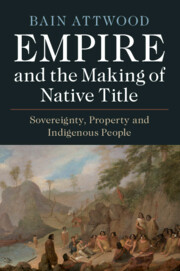Book contents
- Empire and the Making of Native Title
- Empire and the Making of Native Title
- Copyright page
- Dedication
- Contents
- Acknowledgements
- Abbreviations
- Principal Players
- Maps
- Introduction
- 1 Claiming Possession in New Holland and New Zealand, 1770s–1820s
- 2 Batman’s Treaty and the Rise and Fall of Native Title, 1835–1836
- 3 The South Australian Colonisation Commission, the Colonial Office and Aboriginal Rights in Land, 1834–1837
- 4 Protection Claims and Sovereignty in the Islands of New Zealand, 1800–1839
- 5 Making Agreements and a Struggle for Authority, 1839–1840
- 6 The Land Claims Commission and the Return of the Treaty, 1840–1843
- 7 A Colony in Crisis and a Select Committee, 1843–1844
- 8 The Retreat of the Government and the Rise of the Treaty, 1844–1845
- 9 The Making of Native Title, 1845–1850
- Conclusion
- Appendix: The English Text of the Treaty of Waitangi
- Bibliography
- Index
2 - Batman’s Treaty and the Rise and Fall of Native Title, 1835–1836
Published online by Cambridge University Press: 03 July 2020
- Empire and the Making of Native Title
- Empire and the Making of Native Title
- Copyright page
- Dedication
- Contents
- Acknowledgements
- Abbreviations
- Principal Players
- Maps
- Introduction
- 1 Claiming Possession in New Holland and New Zealand, 1770s–1820s
- 2 Batman’s Treaty and the Rise and Fall of Native Title, 1835–1836
- 3 The South Australian Colonisation Commission, the Colonial Office and Aboriginal Rights in Land, 1834–1837
- 4 Protection Claims and Sovereignty in the Islands of New Zealand, 1800–1839
- 5 Making Agreements and a Struggle for Authority, 1839–1840
- 6 The Land Claims Commission and the Return of the Treaty, 1840–1843
- 7 A Colony in Crisis and a Select Committee, 1843–1844
- 8 The Retreat of the Government and the Rise of the Treaty, 1844–1845
- 9 The Making of Native Title, 1845–1850
- Conclusion
- Appendix: The English Text of the Treaty of Waitangi
- Bibliography
- Index
Summary
By examining Batman’s Treaty of 1835 we can put to rest the myth that British players never seriously considered treating with Aboriginal people for land, and that the treatment of sovereignty and rights of property in land in Britain’s Australian and New Zealand colonies was like chalk and cheese. The Port Phillip Association acted in the same manner as many similar groups in the British empire, making an agreement with native people to purchase their land and physically taking possession of territory in the hope that they might thereby be able to force government to concede its claim. But by the mid-1830s, the British Crown had been granting land to settlers for nearly fifty years as though it was the only source of title. This is what some historians would call ‘path dependency’. Moreover, there were no settlers who had no interest in any claim that Aboriginal people were the real owners of the land, and in the eyes of the government the Aboriginal people lacked the military power that would be needed to help bring into being, let alone uphold, a property regime that recognised native rights in land. Consequently, the native title was quickly unmade.
- Type
- Chapter
- Information
- Empire and the Making of Native TitleSovereignty, Property and Indigenous People, pp. 43 - 64Publisher: Cambridge University PressPrint publication year: 2020

